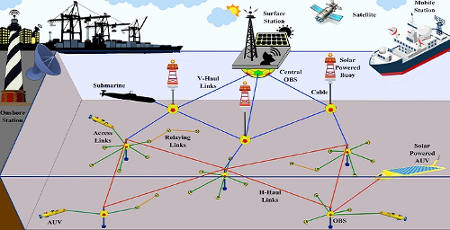The Missing Kingdom: Why Fungi Must Be Central to Conservation Strategy
28 December 2025
Published online 29 March 2018
KAUST scientists create new techniques to optimize underwater wireless sensor networks.

The four-strong team at the King Abdullah University of Science and Technology (KAUST) says the network is capable of transmitting acoustic and optical signals simultaneously, and is a potential solution for the growing demand in high-quality underwater communications.
Underwater acoustic wireless communication systems work over long distances, but are hampered by low data rates (kilobits/sec), long delays and high attenuation, explains Mohammed Slim-Alouini, professor of electrical engineering and associate dean at KAUST.
Nasir Saeed, one of the team, says new research has found that noise created by different acoustic communication systems is harming the health of fish and marine mammals.
While optical communications technology can mitigate these acoustic shortcomings with higher achievable data rates (Gigabits/sec), lower latency and enhanced security, their range is limited to tens of meters due to absorption, scattering and the turbulence of seawater, explains Alouini.
“We believe that a hybrid network which can use acoustic waves for command and control services, and optical waves for high-speed communication services will provide a good alternative to existing underwater wireless systems,” he says.
In this new model, sensors spread across an underwater network transmit signals to data collection surface buoys. For large distances, the sensors transmit acoustic signals, but at closer range, it transmits an optical signal instead.
Because marine research requires accurate localisation techniques, the team used mathematical modeling to develop a proof-of-concept localisation technique to determine the precise location of every sensor at any given time. Each surface buoy collects multiple signal measurements, and then weighs the measurements, giving preference to the most accurate readings in order to calculate where each sensor is positioned.
Dimitris Pados, professor and I-SENSE fellow at Florida Atlantic University, whose research group is working towards the same ends as the KAUST team but through high-acoustic frequencies, says that effective localisation and high data-rate long-distance underwater wireless communications are challenges that the research community has not yet met to their satisfaction.
“The KAUST team addresses both in an ambitious, yet very meaningful, fashion that can reshape the way we communicate under sea,” says Pados.
The use of underwater optical wireless networks can enable numerous applications such as underwater observation systems, instrument monitoring, climate recording, natural disaster prediction, oil exploration, search and rescue missions, navigation and marine life research, according to the KAUST researchers.
However, usefulness hinges on overcoming the high energy consumption of underwater sensor networks. The KAUST team has proposed adding energy-harvesting capabilities to the acoustic-optical nodes to bring reduce consumption. Such nodes could power fuel cells organically, using microscopic algae or piezoelectric (mechanical stress) energy.
The new model has much potential, but Alouini insists much further analysis is needed.
“There is a need to further investigate new theoretical models, developed either analytically or computationally, and testing of underwater optical wireless networks need to be carried out in real underwater environments,” he explains. “There is a dire need to develop underwater optical transceivers which can overcome the problem of link misalignment, low transmission range, low bandwidth, energy consumption, and compactness.”
Pados agrees that existing underwater modems are unsatisfactory, but cautions that the challenges posed by the hostile underwater environment make testing and evaluation of new protocol designs expensive and time-consuming.
doi:10.1038/nmiddleeast.2018.40
1. Saeed, N. et al. Energy harvesting hybrid acoustic-optical underwater wireless sensor networks localization. Sensors http://dx.doi.org/1.10.3390/s18010051 (2018)
2. Celik, A. et al. Modeling and performance analysis of multihop underwater optical wireless sensor networks. Proceedings of the IEEE WCNC https://www.researchgate.net/publication/322069990 (2018)
Stay connected: